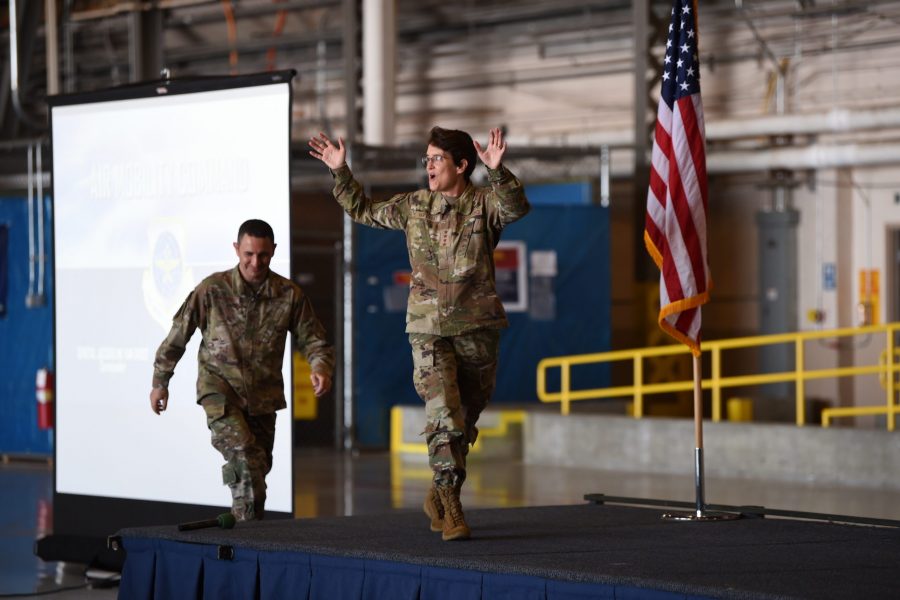Air Mobility Command must accelerate change by developing a force prepared for a high-end fight, advancing new capabilities beyond the traditional role of the heavy aircraft, embracing the role in ferrying the joint force forward, and ensuring the nation’s nuclear mission can be fueled and ready, the new leader of the command said.
AMC boss Gen. Jacqueline D. Van Ovost, who took over the command in August, used a keynote address at the virtual Airlift/Tanker Association conference on Oct. 27 to announce AMC’s new strategy, which follows in the footsteps of new Air Force Chief of Staff Gen. Charles Q. Brown Jr.’s “Accelerate Change, or Lose” directive.
“Now we need to focus and accelerate the command into the future,” Van Ovost said. “Required in this change is greater integration across the services and increased collaboration with all stakeholders to deny our adversaries any seams to exploit.”
The AMC strategy focuses on four key areas, with the first being developing leaders who will be effective in this new era.
“You will be the ones coming up with new operational concepts, you will be the ones rapidly integrating current and emerging technologies, and you will be the ones executing, leading, and making tough decisions in dynamic, ambiguous, and uncertain environments,” Van Ovost said. “You are the strength of this command. We are going to build, train, develop, and sharpen the force for the future high-end fight.”
AMC will focus on resiliency of Airmen to recover and adapt from difficult situations, and develop leaders of “strong character” who will be courageous and focused on the fight.
“Developing the people, concepts, and capabilities that will win against aggressive competitors across the competition continuum must remain at the forefront of our minds and be the lens through which we view everything we do,” she said.
As the broader Air Force continues its push for Agile Combat Employment, AMC will focus on developing Airmen who are multicapable in jobs beyond their main Air Force Specialty Code—a key tenet of the ACE concept. These Airmen will be effective both at a large home base and at small, open-air austere locations. The command will also look to develop Airmen who are digitally adept, with a “foundational knowledge” of emerging technology.
“We can’t capitalize on game-changing capabilities if we don’t even know they exist,” she said. “We must build awareness of the digital environment and bring those capabilities into our problem-solving processes.”
Secondly, the command needs to advance its own “warfighting capabilities” by first being realistic about how the world has changed. “We have to be clear-eyed about the fact that rapid advances in technology have allowed our adversaries to degrade our military competitive advantages,” she said, adding that AMC “can’t assume sanctuary at our bases, especially in multiple domains and command and control.”
“What we do is a physics problem—delivering, refueling, recovering, and enabling,” she said. “We have to advance our ability to beat the physics. Strive toward achieving information and decision dominance by leveraging sensors, information clouds, advanced digital infrastructures, and data analytics.”
Third, AMC as U.S. Transportation Command’s air component serves a key role in delivering joint forces, such as rapidly flying an Army division to the Middle East to respond to an imminent threat like the 82nd Airborne Division’s activation early this year. To effectively serve this mission, the command needs to ensure it can operate in contested environments, through effective exercises and high-end training, so other services can rely on AMC’s capability to deliver them.
Additionally, AMC needs to develop new ways to contribute to a fight. Specifically, Van Ovost highlighted new capabilities on AMC aircraft, such as meshed communication networks on tankers and the ability to deploy munitions or attritable aircraft aboard airlifters, as ways the command can contribute more to a fight.
Lastly, AMC needs to focus on its “no-fail” mission of strategic deterrence.
“With the re-emergence of great power competition, focused efforts and aggressive actions by other nations to modernize, expand, and develop nuclear capabilities, and the increased salience of nuclear forces in their strategies and plans, our nation now faces a more diverse and advanced nuclear threat environment than ever before.”
The command’s role focuses on assured air refueling and airlift support to nuclear forces while also enabling global diplomacy by carrying the country’s senior leaders. Going forward, making credible capacity in its tanker fleet is a top priority. This includes upgrading legacy tankers such as the KC-135 and bringing on the KC-46, which is both late and facing capability issues. Additionally, the command will “aggressively pursue” upgrades to command posts, aircraft, and its 618th Air Operations Center to ensure it will stay connected.
“These are no-fail missions for us and we will prioritize our ability to continue to execute regardless of the environment because we use deterrence daily to ensure America’s freedoms and way of life are protected,” Van Ovost said.
